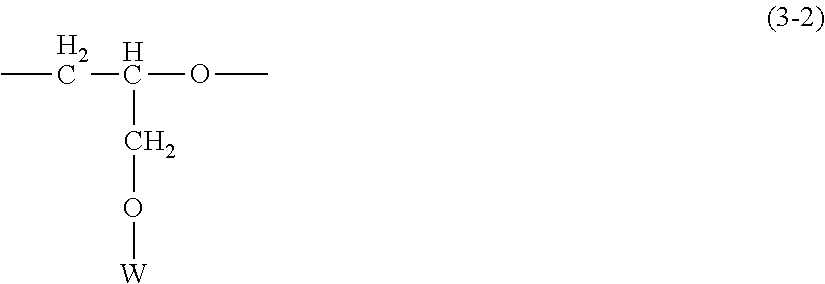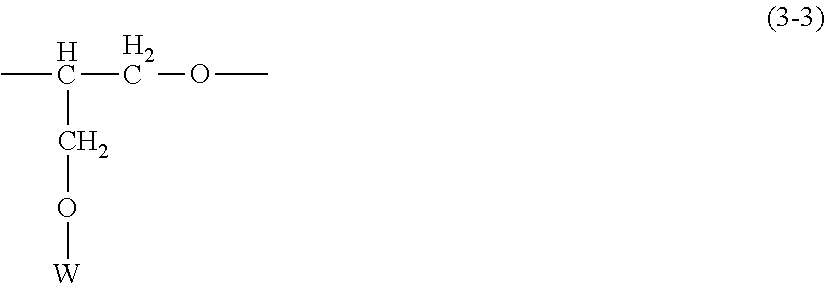Cosmetic for hair containing co-modified organopolysiloxane
a technology of organopolysiloxane and co-modified organopolysiloxane, which is applied in the field of hair cosmetics, can solve the problems of hair loss, hair loss, and hair loss, and achieve the effects of smooth combability, flexible styling sensation, and smooth combability
- Summary
- Abstract
- Description
- Claims
- Application Information
AI Technical Summary
Benefits of technology
Problems solved by technology
Method used
Image
Examples
synthesis example 1
Synthesis of Silicone Compound No. 1
[0384]196.6 g of a methylhydrogenpolysiloxane represented by the following average compositional formula: MD400DH10M, 13.6 g of a vinyltristrimethylsiloxysilane represented by the following average compositional formula: CH2═CH—Si(OSiMe3)3, 5.5 g of glycerol monoallyl ether represented by the following structural formula: CH2═CH—CH2—OCH2CH(OH)CH2OH, and 90 g of isopropyl alcohol (IPA) were placed in a reactor, and the mixture was heated to 70° C. under a nitrogen stream while it was stirred. 0.060 g of a solution of a platinum-1,3-divinyl-1,1,3,3-tetramethyldisiloxane complex (Pt concentration=4.5% by weight (mass)) dissolved in IPA was added thereto, and the mixture was reacted for 5 hours at 80° C. Subsequently, with 2 g of the reaction mixture, it was confirmed that the reaction was completed, by means of an alkaline decomposition gas generation method (remaining Si—H group was decomposed by an aqueous solution / ethanol of KOH, and reaction inde...
synthesis example 2
Synthesis of Silicone Compound No. 2
[0385]151.3 g of a methylhydrogenpolysiloxane represented by the following average compositional formula: MD150DH10M, 26.7 g of a vinyltristrimethylsiloxysilane represented by the following average compositional formula: CH2═CH—Si(OSiMe3)3, 11.7 g of polyglycerol monoallyl ether, 10.2 g of diglycerol monoallyl ether and 200 g of IPA were placed in a reactor, and the mixture was heated to 65° C. under a nitrogen stream while it was stirred. 0.100 g of a solution of a platinum-1,3-divinyl-1,1,3,3-tetramethyldisiloxane complex (Pt concentration=4.5% by weight (mass)) dissolved in IPA was added thereto, and the mixture was reacted for 5 hours at 80° C. Subsequently, with 2 g of the reaction mixture, it was confirmed that the reaction was completed, by means of an alkaline decomposition gas generation method. The reaction mixture was heated under reduced pressure to remove low-boiling components by distillation. Thereby, a polyglycerol-modified silicon...
synthesis example 3
Synthesis of Silicone Compound No. 3
[0387]109.3 g of a methylhydrogenpolysiloxane represented by the following average compositional formula: MD72DH12M, 66.3 g of a vinyltristrimethylsiloxysilane represented by the following average compositional formula: CH2═CH—Si(OSiMe3)3, 24.3 g of polyglycerol monoallyl ether, 200 g of IPA, and 0.23 g of a solution containing 2.3% by weight (mass) of sodium acetate dissolved in methanol were placed in a reactor, and the mixture was heated to 50° C. under a nitrogen stream while it was stirred. 0.160 g of a solution containing 5% by weight (mass) of chloroplatinic acid dissolved in IPA was added thereto, and the mixture was reacted for 7 hours at 80° C. Subsequently, with 2 g of the reaction mixture, it was confirmed that the reaction was completed, by means of an alkaline decomposition gas generation method. The reaction mixture was heated under reduced pressure to remove low-boiling components by distillation. Thereby, a polyglycerol-modified s...
PUM
| Property | Measurement | Unit |
|---|---|---|
| viscosity | aaaaa | aaaaa |
| viscosity | aaaaa | aaaaa |
| viscosity | aaaaa | aaaaa |
Abstract
Description
Claims
Application Information
 Login to View More
Login to View More - R&D
- Intellectual Property
- Life Sciences
- Materials
- Tech Scout
- Unparalleled Data Quality
- Higher Quality Content
- 60% Fewer Hallucinations
Browse by: Latest US Patents, China's latest patents, Technical Efficacy Thesaurus, Application Domain, Technology Topic, Popular Technical Reports.
© 2025 PatSnap. All rights reserved.Legal|Privacy policy|Modern Slavery Act Transparency Statement|Sitemap|About US| Contact US: help@patsnap.com



